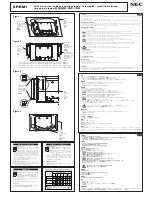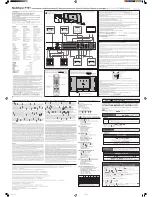
5HSDLU7LSV
3. Lead-free product identification
You can identify lead-free product by Philips-lead-free logo on PCB.
4. Lead-free product repair instruction
4.1 Use only lead-free Solder Alloy 0622 149 00106(1.2mm SAC305) or 0622 14900108(1.0mm SAC305).
Remark: For lead free soldering material, please visit
www.alphametals.com
website for details. This is recommended by Philips.
4.2 Use only adequate solder tools applicable for lead-free soldering-tin. The solder tool must be able to reach at least a solder-temperature of 400, to
stabilize the adjusted temperature at the solder-tip and to exchange solder-tips for different applications.
Small Passives/Actives to be removed with thermal tweezers
Automated system for IC and BGA repair (Microscope, Camera, Beam split optics, Computer, Programmer, Heat controllers, Vacuum system, Laser
pointer) Solder Hand-Tool (Adjustable in temperature height, Temperature shall be held constant, Flexible tips)
4.3 Adjust your solder tool so that a temperature around 360 -380 is reached and stabilized at the solder joint.
Heating-time of the solder-joint should not exceed ~ 4 sec. Avoid temperatures above 400 otherwise wear-out of tips will rise drastically and flux-fluid will
be destroyed. Corrosion of Tool-Spikes can be avoided when using SAC305 and a temperature of less than 400.
4.4 Mix of lead-free solder-tin/parts with leaded soldering-tin/parts is possible but not recommended. If not to avoid clean carefully the solder-joint from old
tin and re-solder with new tin.
4.5 Use only original spare-parts listed in the Service-Manuals. Standard-material (consumables) can also be purchased at external companies.
4.6 Special information for lead-free BGA-ICs: this ICs will be delivered in so-called dry-packaging to protect the IC against moisture and with lead-free
logo on it. This packaging may only be opened shortly before it is used (soldered). Otherwise the body of the IC gets wet inside and during the heating
time the structure of the IC will be destroyed due to high (steam-) pressure. If the packaging was opened before usage the IC has to be heated up for
some hours (around 90 ) for drying (Take attention for ESD-protection!)
5. Rework on BGA (Ball Grid Array) ICs
General
Although (LF)BGA assembly yields are very high, there may still be a requirement for component rework. By rework, we mean the process of removing
the component from the PWB and replacing it with a new component. If an (LF) BGA is removed from a P WB, the solder balls of the component are
deformed drastically so the removed (LF)BGA has to be discarded.
Device Removal
As is the case with any component that, it is essential when removing an (LF) BGA, the board, tracks, solder lands, or surrounding components are not
damaged. To remove an (LF)BGA, the board must be uniformly heated to a temperature close to the reflow soldering temperature. A uniform temperature
reduces the chance of warping the PWB.
To do this, we recommend that the board is heated until it is certain that all the joints are molten. Then carefully pull the component off the board with a
vacuum nozzle. For the appropriate temperature profiles, see the IC data sheet.
Area Preparation
When the component has been removed, the vacant IC area must be cleaned before replacing the (LF) BGA. Removing an IC often leaves varying
amounts of solder on the mounting lands. This excessive solder can be removed with either a solder sucker or solder wick. The remaining flux can be
removed with a brush and cleaning agent. After the board is properly cleaned and inspected, apply flux on the solder lands and on the connection balls of
the (LF)BGA
Note: Do not apply solder paste, as this has shown to result in problems during re-soldering.
Device Replacement
The last step in the repair process is to solder the new component on the board. Ideally, the (LF) BGA should be aligned under a microscope or
magnifying glass. If this is not possible, try to align the (LF)BGA with any board markers. To reflow the solder , apply a temperature profile according to
the IC data sheet. So as not to damage neighbouring components, it may be necessary to reduce some temperatures and times.
More Information
For more information on how to handle BGA devices, visit this URL: http://www.atyourservice.ce.philips.com (needs subscription). After login, select
Magazine, then go to Workshop Information. Here you will find Information on how to deal with BGA-ICs.
192E2SB2 LCD
83
Содержание 192E2SB2/10
Страница 7: ...192E2SB2 LCD 7 Troubleshootingʳ ...
Страница 8: ...8 192E2SB2 LCD Troubleshooting ...
Страница 19: ...192E2SB2 LCD 19 FAQs Frequently Asked Questions ...
Страница 20: ...20 192E2SB2 LCD FAQs Frequently Asked Questions ...
Страница 23: ...192E2SB2 LCD 23 Service tool Hardware PCM code 12NC 5E L8215 001 996510019769 ...
Страница 24: ...24 192E2SB2 LCD Service tool Software FW writing tool Easy Writer V4 54 DDC writing tool Q EDID V16 ...
Страница 36: ...36 192E2SB2 LCD Firmware Upgrade for CPU Step 4 Press Auto to upgrade FW ...
Страница 37: ...192E2SB2 LCD 37 Firmware Upgrade for CPU Step 5 Upgrade OK ...
Страница 39: ...192E2SB2 LCD 39 LULQJ LDJUDP ...
Страница 40: ...40 192E2SB2 LCD ORFN LDJUDP ...
Страница 46: ...S c alar Diagram C B A 46 192E2SB2 LCD ...
Страница 49: ...192E2SB2 LCD 49 3 Power Diagram C B A ...
Страница 50: ...3 Power Diagram C B A 50 192E2SB2 LCD ...
Страница 52: ...Control Diagram C B A 52 192E2SB2 LCD ...
Страница 79: ...Exp lode d View 192E2SB2 LCD 79 ...




































